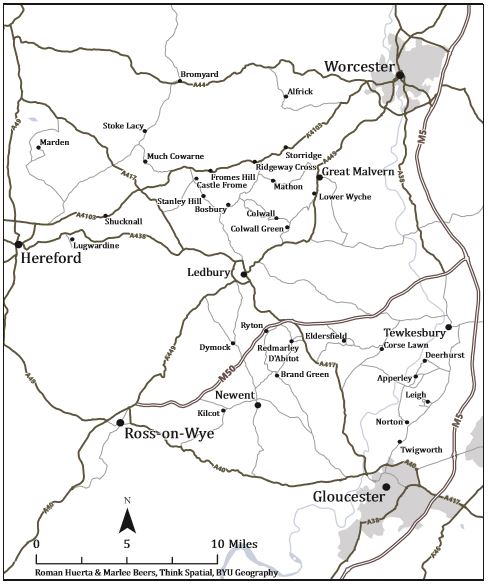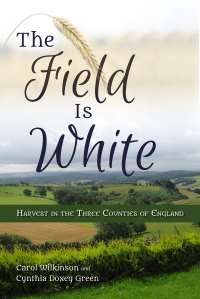Preface
Carol Wilkinson and Cynthia Doxey Green
Carol Wilkinson and Cynthia Doxey Green, “Preface,” in The Field Is White, Carol Wilkinson and Cynthia Doxey Green (Provo, UT: Religious Studies Center; Salt Lake City: Deseret Book, 2017), iii-xii.
 Map of the triborder area of the Three Counites
Map of the triborder area of the Three Counites
The genesis of this book occurred in 2005 when a member of the stake presidency from the Cheltenham Stake of The Church of Jesus Christ of Latter-day Saints in Gloucester, England, contacted administrators at Brigham Young University, Provo, Utah, asking if it was possible for scholars from the university to write a history of the early days of the Church in the counties of Herefordshire, Gloucestershire, and Worcestershire (commonly referred to as the Three Counties). The stake presidency was specifically interested in finding out more about the missionary work of Wilford Woodruff in the early 1840s, to provide clarification of the number of baptisms that took place during this time period. Although there was a general understanding that a large group of people joined the Church as a result of Wilford Woodruff’s preaching, some people have questioned the actual number of baptisms.
The university administrators directed the member of the Cheltenham stake presidency to talk to Paul Peterson, the chair of the Department of Church History and Doctrine. After discussing the proposal, Paul agreed to take on the project and invited us to join him in the endeavor. Paul, Carol Wilkinson, and Cynthia Doxey Green began researching the history of the Church in the Three Counties using records that were available in Utah. Through generous grants from Brigham Young University’s International Vice President’s Office, Religious Education, and the Church History and Doctrine Department, all three of us were able to spend time researching on-site in Herefordshire, Worcestershire, and Gloucestershire at different times over the next couple of years. Sadly, in 2007, Paul succumbed to the cancer he had been battling for years, leaving the project for us to finish. The story of Wilford Woodruff’s great success in the Three Counties area of England has previously been documented to some degree but, based on the charge given to us, we felt it necessary to explore these missionary experiences in more detail.
In this book, before commenting on Wilford Woodruff’s activities in the Three Counties, we explore the background of what had occurred in England prior to Elder Woodruff’s arrival there in 1840. To accomplish this, chapter 1 focuses on the experiences of the first missionaries who arrived in England in 1837 and the early efforts to give the Church a base there. In chapter 2 we look at the background of the Three Counties area and the people who initially joined the Church to see how the political, social, economic, and religious milieu of the time influenced their lives and prepared them for the message of the restored gospel initially brought to them by Wilford Woodruff. Chapter 3 moves on to describe Wilford Woodruff’s missionary experiences in this part of England. One of the strengths of this research is that we accessed a number of journals and life stories of other missionaries, including British missionaries, who labored in this area. Chapter 4 describes many of these stories, providing a more complete picture of the growth of the Church.
Because this research was initiated to determine the number of baptisms during the time of Wilford Woodruff’s mission to the Three Counties, we discuss the research process we used and our findings from a variety of records to augment the reports from Wilford Woodruff’s own words. Chapters 5 and 6 briefly describe how we created two databases of converts from the Three Counties: one coming from names listed in missionary and member journals, and the other coming from names found in the Church membership records of the time. In addition to compiling the names and any identifying information about these converts from those original records, we searched for information about their lives in public records such as Family Tree (from FamilySearch.org), census records, and emigration records. For the interested reader desiring to know more details about the research processes, the appendix explains the sources we used, along with the way we found many of the records and homes of many of the early converts from the Three Counties.
Chapter 5 looks at how many converts joined the Church during Wilford Woodruff’s mission, also describing the demographic information about the converts: gender, age, occupations, and social status. Chapter 6 answers many questions about what the converts did after their initial acceptance of the gospel: How many converts emigrated to America to join the body of the Saints? How many went west with the Saints from Nauvoo to Utah? Why did many of the converts remain in England? Interspersed in the analyses of our databases, we include stories of many of the English converts who left journals or reminiscences of their lives, describing their joys and struggles as they embraced their newfound faith. This is not a comprehensive history of all the converts from the Three Counties. We know there are many converts whose stories we have not told. We focused on the primary sources that we could locate, knowing that there are other stories that the converts’ descendants could tell.
Finally in chapter 7, we conclude with a look at the current situation of the Church in the Three Counties area at the beginning of the twenty-first century to see how the Church has changed and how current members of the Church have forged links with the legacy left to them from this amazing time of harvest in the mid-1800s. We also share information about places of historical interest as found in the Three Counties today.
Acknowledgments
We would like to express appreciation to Brigham Young University’s International Vice President’s Office, Religious Education, and the Church History and Doctrine Department for their generous support of this project in providing funds for our research both in England and for student research assistants at Brigham Young University. We appreciate the invaluable help of Wayne Gardner and Simon Gibson, with whom we visited in the Three Counties of England, in helping us understand current efforts of Church members to connect with the legacy left to them from the time of harvest in the 1800s. We also appreciate the help of William W. Slaughter, Emily Utt, Jay Burrup, and many others at the Church History Library of The Church of Jesus Christ of Latter-day Saints who provided insight and access to several of the journals and photographs used in this research. We want to thank Sharon Black for her wonderful editorial help with the manuscript. We express gratitude to Thomas A. Wayment, Joany O. Pinegar, Brent R. Nordgren, Devan Jensen, Leah Emal, Allyson Jones, and Carmen Cole of the Religious Studies Center. Finally, we appreciate the numerous student assistants who helped us conduct the family history research for the hundreds of people who joined the Church in the Three Counties in the mid-nineteenth century. There are too many students to mention, but we want them to know their work was important to the success of this project.
